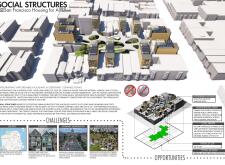5 key facts about this project
San Francisco is currently facing a severe housing crisis marked by rising costs and social inequality. “San Francisco Housing for All” offers a solution that integrates affordable housing within the city’s existing urban framework. The design addresses critical housing needs while fostering community connections through a modular, multi-family dwelling concept that honors the historical and cultural context of the area.
Design Concept and Strategy
The focus is on developing modular multi-family units that increase housing capacity in a crowded city. By suggesting an increase in height limits in various neighborhoods, currently capped at 40 feet, the design aims to maximize available space for housing. This approach not only responds to the urgent demand for affordable housing but also revitalizes the urban landscape through careful architectural choices.
Integration of Community Spaces
A central idea of the design is the inclusion of shared spaces, which are essential for fostering social connections among residents from different backgrounds. The proposal features a central common green space and a community park, which provide gathering places for people. By creating accessible outdoor areas, the design helps to reduce social divides, offering important opportunities for community interaction that bring people together.
Architectural Language and Façade
The architectural style incorporates a façade that adapts to the unique characteristics of San Francisco’s neighborhoods. This flexibility is important for blending new buildings with the existing urban setting, ensuring they fit well with local architectural styles. By considering the local aesthetic, the design promotes acceptance and encourages engagement within the community, contributing to a more cohesive urban environment.
Environmental Sustainability
Attention to green spaces highlights a commitment to environmental care and the overall well-being of residents. The design includes communal gardens and landscaped areas that enhance the urban environment and provide necessary outdoor access. These green spaces act as gathering spots, encouraging social interaction and promoting a healthier lifestyle in the busy city setting.
The approach uses arranged pathways and community-focused features to deepen connections among residents. This effort serves as an important response to the housing challenges facing the city while enriching the social fabric for everyone living there.






















































